Ways to finish the ceiling of bathrooms and moisture-resistant materials. Suspended, tail and stretch designs. Installation technology ceiling systems.
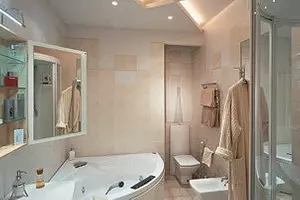
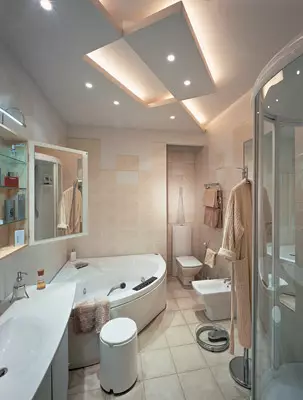
Photo by Konstantina Dubovets
Adjustable suspensions (rods, brackets, thick wire) allow you to change the distance between suspended and base ceilings, which makes it possible to mask irregularities and create multi-level surfaces
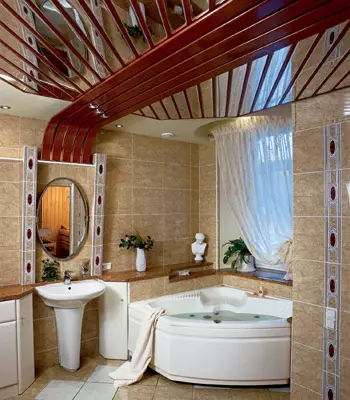
Photo George Shablovsky
Rank structures are collected from narrow long rails, which may vary in width, configuration, texture (matte or mirror) and color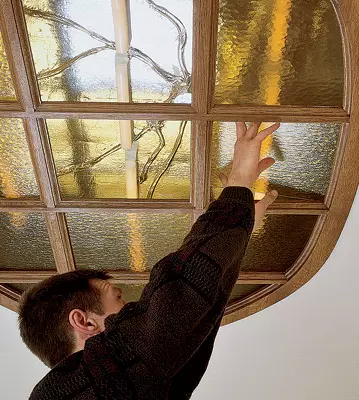
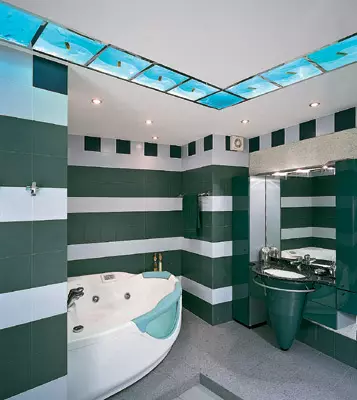
Photo Zinur Ranidovnova
Combined ceiling using stained inserts. Internal illumination reveals their drawing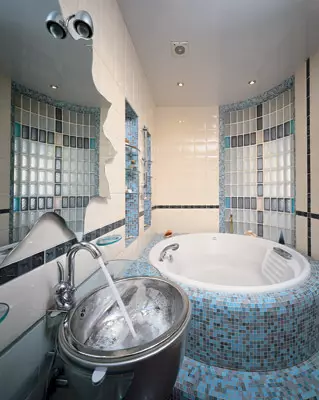
Photo Vitaly Nefedova
Bold shape of a mirror, bright tile tones, a bath with a mosaic facing ... Exchange interior of the bathroom is equalized by a white ceiling plane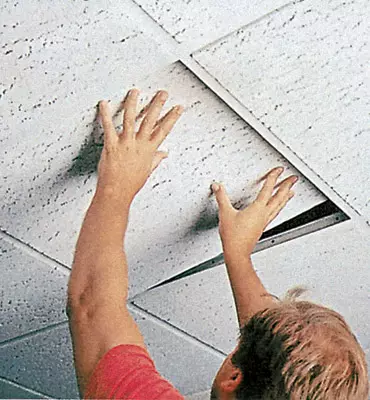
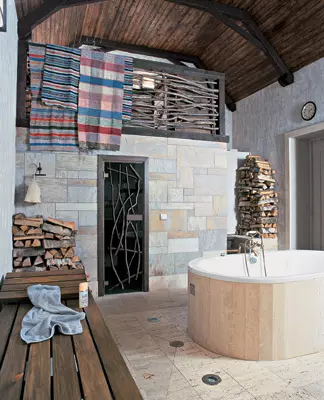
Photo of Peter Lebedev
We are truly a "rustic" house, if possible, avoided the use of artificial materials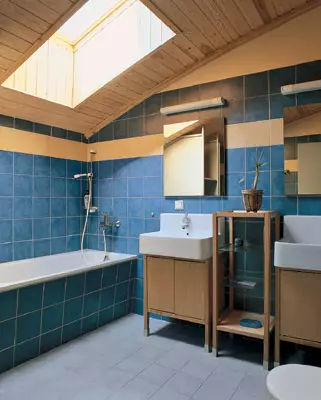
Photo Mikhail Stepanova
Natural lighting - rarity for the bathroom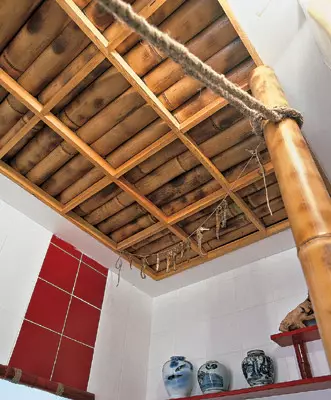
Photo Vitaly Nefedova
Bamboo ceiling in the bathroom finish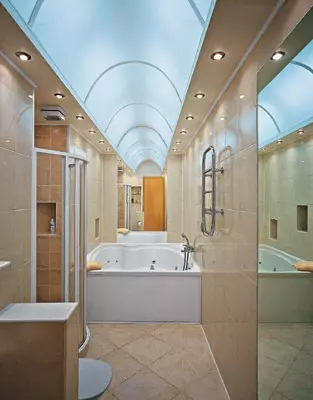
Photo George Shablovsky
Install the mirror in the entire wall, build the arched ceiling, and the illusion of the elongated space will occur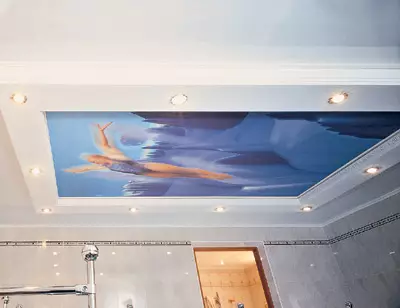
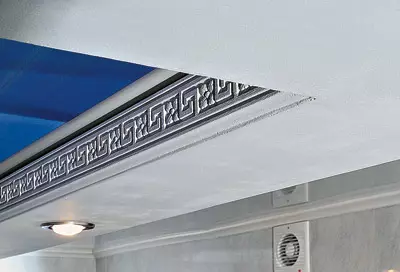
Pretty ceiling canvas with fantastic computer graphics: a diver flying on the background of an ice alien landscape. On the perimeter of the canvas passes a plasterboard eaves, decorated with embossed ornament with antique meander and highlighted by built-in lamps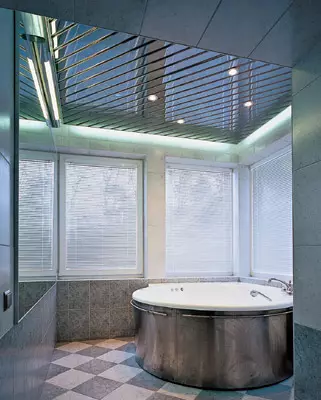
Photo of Karen Manko
Dark Blue Ceiling Design Supports Shared Bathroom Style, Discreit and Lacon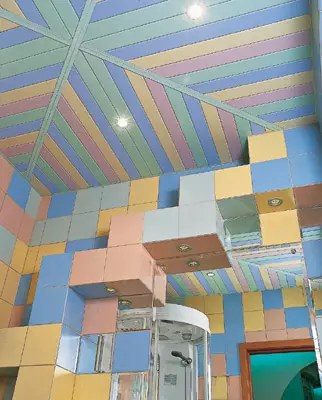
Photo Mikhail Stepanova
Combination of rivers of different colors and change directions - a successful find for this playful bathroom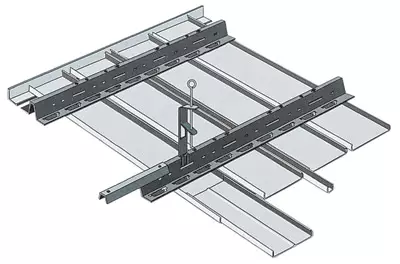
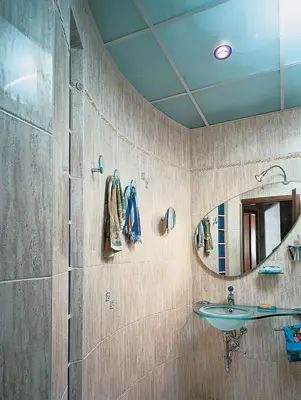
Photo by Dmitry Minkina
Modular suspended design of colored plexiglas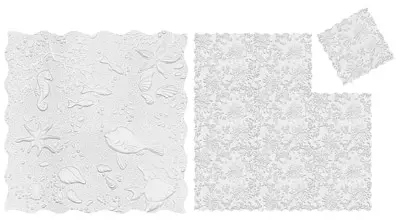
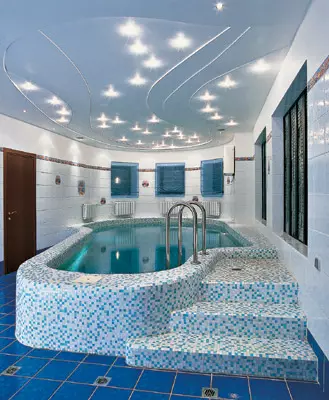
The multi-level ceiling of the complex configuration is made of plasterboard. The level difference is underlined by backlight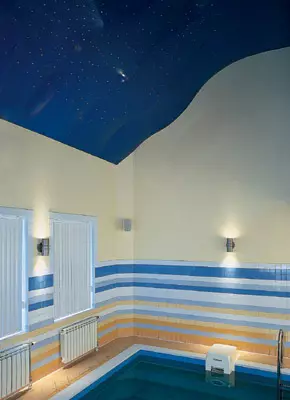
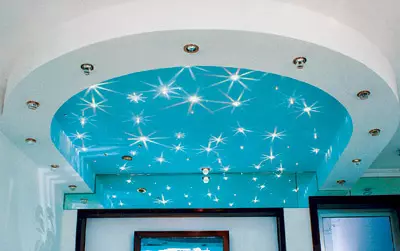
"Star Sky" using optical fiber technology and using Swarovski lens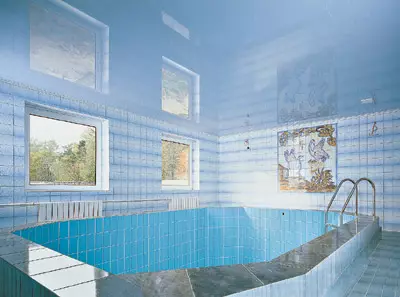
PVC film tension ceiling is immune to water and high humidity, so it can be installed in wet rooms without any restrictions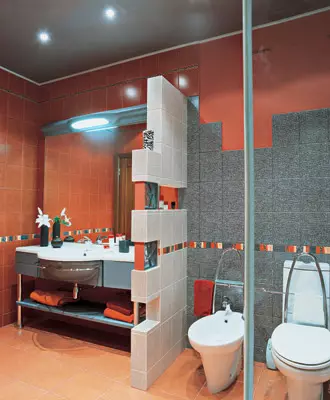
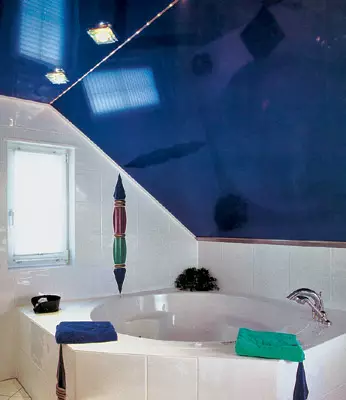
Stretch ceilings can be installed in rooms of the most different configuration, building multi-level structures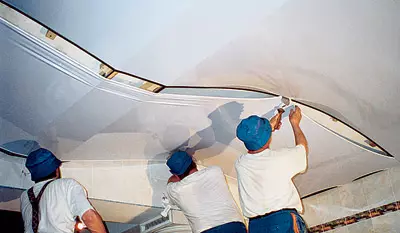
Installation of stretch ceiling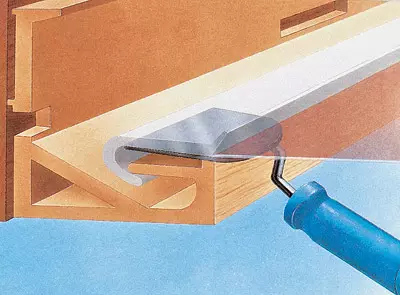
During the construction and repair of premises with high humidity, it is necessary to show special attention to the selection of materials, because they must all resist the destructive effects of water. In other words, be moisture-resistant. No exception and those that are used to finish the ceilings.
Wet calls are indoors where the air humidity exceeds the normal indicator (60%). The books include pools, saunas and bath (humidity of more than 90%), kitchens, laundries, winter gardens (70-80%), and of course, bathrobes and toilet rooms, showers. The surface of the ceiling, in addition to constant contact with wet air, can and directly contact with water (for example, in shower) or be the condensate formation site (let's say, with sharp drops of temperature).
Coatings with incorrectly chosen moisture resistance after a while begin to either flavor, and then the ceiling saves, or undergo corrosion, the effects of fungi and bacteria. All other requirements for nimble-reflective and sound-absorbing ability, fire resistance, environmental purity, simplicity in leaving, fully correspond to the general presented to conventional ceiling constructs.
The ceilings can be divided into two groups. The clerva includes those whose finishing base is the overlap itself. For their design, there is a fairly limited number of methods (for example, plastering and paint, sticking of decorative coatings; for wooden surfaces is a processing of various impregnations). The second group includes ceilings, providing for the construction of an additional construction based on the main and formative fundamentally new plane (suspended, cortex and stretch).
Painted ceiling
Coloring - the traditional and cheapest method of finishing the ceiling. Works are carried out before the walls and flooring in the room. Old coating layers are removed, and then proceed to the preparation of the base. Details The technology of the pre-processing process is described in the material "Are you still in white?".Only special materials are suitable for staining the ceiling in the bathroom. They are also called paints for wet premises. These may be compositions on acrylic, latex or silicone basis, separate water dispersive, as well as oil paints.
In the Russian market, water resistant paints are presented highly wide: FUR Kuche Bad (Practic, Germany), Indeco-W (Caparol, Germany), Duefa Eco-Weiss (Meffert, Germany), Crown (Akzo Nobel, Netherlands), Dyoterm (DYO, Turkey ). Some, such as Dyostop (DYO), can be applied even on raw surfaces. From domestic products we call such materials as "A-25" of Akron-B, "Raduga M4" from Rick.
The ceilings are usually made either white, or by adding special killers into the composition, paint them into the tone of the wall tile. If the paint does not contain antifungal components, you can buy a special solution (say, Weatherhield Fungicidal Wash from Ici Paints, United Kingdom; consumption-30m2 / l, cost 1 l- $ 8) and process them the entire surface to color. For the ceiling finishing, conducted by a qualified master, will have to pay from $ 10 for 1m2 (full cycle of work, without taking into account the value of materials).
In addition to the paints, there are entire sets of compositions for ceilings in wet rooms, for example, the Tikkurila Luja complex designed specifically for the bathrooms. The assembly includes 4 components: moisture insulation primer, moisture-resistant adhesive Assatex, fiberglass wallpaper and acrylic Luja paint. Works are carried out in several stages: first put a layer of primer, then a glass-resistant glue is fixed with glassy. After a day, a moisture insulation primer is applied on top of the wallpaper with roller and only after this 2 layer of paint. If you wish to update the ceiling earlier than the expire for the shelf life of this coverage, you can simply impose a new paint layer. The surface trimmed in this way is suitable for washing not only by ordinary household, but also by strong detergents, including disinfectant. The paint itself is able to withstand more than 10,000 passes with a brush. Cost 1l - from $ 7. A set of waterproof primers (Resistent Tackfarg) offers also the Swedish firm Beckers.
The disadvantage of painted ceilings is the need to carry out a long cycle of work on preliminary surface preparation, indisputable advantage of a similar type of finishing is the availability of materials.
Embedded ceiling
"Adhesive", "glued", "salary" - all these names related to the same type of ceiling finishes are equally among the builders and sellers of building materials. We are talking about the ceilings, on the smooth base of which various decorative coatings of polystyrene plates, glass, cork or laminated panels or ceramic tiles are glued.
Plates from foamed polystyrene are most popular (or, as it is also called, styrofoam). Only extruded modules are suitable for use in wet rooms. The extrusion method, which is used in their production, allows for maximum density (about 70kg / m3) and uniformity of the material, and therefore waterproof. In the manufacture of plates with other methods, stamping and injection - their structure is not obtained by such a homogeneous, and the coating can absorb moisture.
Extruded plates are easy to distinguish in appearance: the facial surface is smooth, a homogeneous structure, in the context, the panel is similar to a porous chocolate tile. The accuracy of the extruded, stamped and injection materials have a clearly pronounced grain structure, tangible even to the touch. Products also differ in thickness: extruded - 2.5-3mm, stamped- 6-7mm, injection - 10mm. The standard size of modules in all manufacturers is the same - 500500mm. Punching additional elements are available rectangular panels 16.5 mm wide and 1000 mm long, as well as ceiling plinths 1000-1500mm. The most popular colorful color, a variety here is achieved at the expense of a particular surface texture (in catalogs firms are presented to several dozen options). Although, if desired, you can choose and color samples, including imitating wood, cloth or stone.
In the Russian market today are offered mainly by the plates of domestic producers: "Greaches", "Decomaster", "Plast Gamma Decor", as well as some foreign-decora, Marbet, VTM (Poland), Schafer, Deckenplatten (Germany). The cost of white panels - approximately 40 rubles / m2, color- about 60-70 rubles / m2.
The polystyrene foam plates are glued on any base - concrete, brick, clay blocks, wood (preferably with pre-primer). When finishing the old surfaces, it is imperative to remove the lagging strata of paint, it is not necessary to consider all the paint. It is better to use glue for polystyrene or a special moisture resistant composition for ceiling floors (Decomaster of the Russian company "Decomaster", Gigant DFA German MEFFERT, TITAN Polish Marbet IDR.). In place, you are guaranteed not to spoil the tile, and subsequently you can easily dismantle it. It is easy to care for glued ceiling: it is required only from time to time to carry out wet cleaning.
Despite the rapidness, foamed polystyrene is quite easy to melt (at temperatures above 80c, the material begins to deform). Therefore, it should not be located wall-mounted and ceiling lights at a distance closer than 20-30 cm from the ceiling surface. Water heating pipes, as practice testifies, do not warm up to the melting point of polystyrene, and the panel can be mounted even close to the pipes. Stirores does not withstand the effects of organic solvents (gasoline, turbidar, acetone IDR), but the traces of fat from white plates are washed off with alcohol. Inacontament, polystyrene foam artificial material, for which it dislikes fans of all natural. Buyers also often complain of a significant difference in the sizes of plates from one batch of goods.
The use of glasses is one of the most comfortable and inexpensive methods of finishing the ceiling in a wet room. The advantages of their application are the possibility of multiple staining (10-15 times) and long service life (up to 20-30 years). The Russian market offers glass equipment such European manufacturers like Baumax (Germany), IHT Interglas HGT (Austria), Fintex (Finland). The cost of the roll is 50m, from 800 rubles. Surface texture is very diverse: parquet, rhombus, diagonal, Christmas tree, Rhozhod.
You can stick to the ceiling in the bathroom and cork tiles treated with a special water-repellent impregnation. Special ceiling samples are not found on sale, so that they go both outdoor and wall products from the plug. This material, by the way, has very good thermal insulation properties. In the same way, "not intended", waterproof laminated coatings or a conventional ceramic tile are used.
Removing old coatings
There are three main ways to remove old coatings: mechanical (scraping with brushes, Occuring with a coarse-grazing abrasive skin, cleaning by grinding machine or special nozzles on a drill, sandblasting), thermal (using a construction dryer or thermopystole; oil paint is also removed by the Dedovo method, Having warmed the surface with the usual iron through aluminum foil) and chemical, for which Russian, and foreign companies produce a huge amount of diverse washes. We serve only a few examples: Tapeten und Leimfarbenabloser (PUFAS, Germany), DFA Abbeizer (MEFFERT, Germany).
Wooden ceiling
Wooden ceilings in the bathroom is the optimal solution for country houses, where it is not necessary to separate these structures by any waterproof materials. A more promising is an option to work with the tree itself, for example, the impregnation of the ceilings with special water-repellent biological preparations that protect the tree not only on the effects of moisture and rotting, but also from the spread of bum-pests. This goal can be used, say, by the BB-11 bioognevoshet, Russia; cost- 60 rubles. / Kg), the means "Sezheng Bio" ("Seine-preparations", Russia; packaging price 10kg- 166 rub.; applied in 2-3 layers); The combination of preparations "Sotetks" and "Akvateks" produced by Rogneda (65 rubles / l). Processing the material is better before the start of construction, but it will cost it more expensive.A separate conversation of the ceilings in the sauna and a bath, where, together with walls and gender, their surface is subjected to a periodic "massive attack" of moisture. Here, a tree (with the exception of aspen, which is the best material for saunas) should be treated with special compositions withsting the effects of high temperatures. For example, the impregnation of the Teflex Sauna from the company "Bioprotect" or the composition based on Acrylate Supi-Saunasuoja firm Tikkurila (Finland). Although some experts strongly recommend leaving a tree in Pure Pillarks and do not cover it with any drugs. They explain this in the inability to achieve the complete absence of evaporation of "chemistry."
Suspended ceiling
This is a system consisting of a metal frame suspended to overlapping, and the finished modules (railings, plates, panels, cassettes), which form a new surface of the ceiling below the base.
Suspended system, or frame, is the basis of any suspended ceiling. The framework of the main guides, transverse guides, angular elements and suspensions. Adjustable suspensions (rods, brackets, thick wire) allow you to change the distance between the suspended and the basic ceilings. This design makes it possible to mask irregularities, create multi-level surfaces, use the resulting space for laying the necessary engineering communications and installation of lamps. Standard color suspended system - white, there are also options under chrome, under gold, color. The width of typical guides is 15 and 24mm. Kbasy ceiling the suspensions are attached with the help of dowels and screws.
Rack designs are collected from narrow long rivers, which may vary in width, height, configuration, edge shape, texture (matte or mirror) and color. Neighboring modules are able to assemble the joint into the joint, to be divided into the insert or is located at some distance from each other (in the latter case, the maximum open ventilated structure is obtained). Reiki curved form (made at the factory under the order in the size of the customer) allow you to create curvilinear ceilings. In addition, in one structure, the modules of the straight and curved shape, different colors, lamps inserts and insertion blocks are combined. The standard length of the RECEX is 6m, width - from 30 to 300 mm, thick - from 0.3 to 0.6mm. They are made of aluminum or galvanized steel, for wet rooms it is recommended to choose aluminum. Products are available in the assortment of all manufacturers of rush ceilings: ArmStrong (USA), GeiPel (Germany), Catena, Prometal (Italy), Hunter Douglas (Germany, Luxalon Brand), Inlook (Finland), Lumsvet, Albes (Russia ).
The price of the rush design of Russian production is $ 10-20 per 1m2, foreign samples - $ 20-40 per 1m2, the cost of installation works - from $ 8 for 1m2. Watching the leakage on top of the rail should be removed and dried, and then return to the place; Open design will dry without dismantling. Thanks to its practicality in operation, suspended ceilings are very popular with consumers and are installed mainly in the bathrooms.
Tile modular structures in our market are represented by two standards with systems. According to European, cell cells have dimensions of 600600mm, and modules 595595mm. American - 610610 and 605605m, respectively. Systems are universal and allow the use of plates of one standard from different manufacturers.
The main types of suspended ceilings modules:
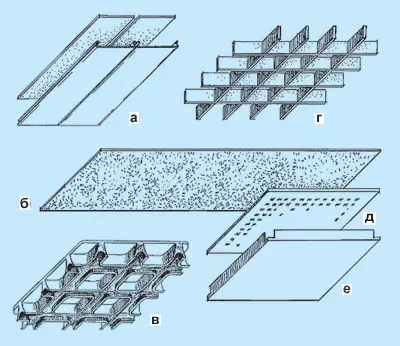
b-panel;
Machy module;
g-lattice;
dbr;
Etzset.
Modular elements are made of various materials: metal (steel or aluminum), wood, Feds, MDF, mineral fiber (including fiberglass), plastic, drywall. No restrictions on the use of steel and aluminum products in wet rooms (they are produced by Albes, Russia; Conter, Italy; AMF, Germany), plastic elements (Sibu Design, Austria), Plexiglas modules (Altuglas, Holland; Barlo Plasrix , Slovakia; Plexiglas, Germany; "Orcseklo", Russia). The plates from other materials must in this case necessarily have a moisture resistance of at least 95% (and for pools - 100%). Such are the products made of mineral fiber Newtone and Ceramaguard from ArmStrong, capable of withstanding even constant contact with water; Fibrous fibrous plates of Fibracoustic and plates from the Mineral Wool Thermatex produced by AMF. You should also mention POP fiberglass modules (Ecophon, Sweden) coated with PVC film from the front side, and Mineral Fiber Modules Ceramic Radar (USG, USA). The thickness of the elements depends on the material from which they are made: from 0.5 mm (metallic) to 20-30 mm (from mineral fiber). Their surface can have a different color, to be smooth or rough, matte, glossy or mirror. Extracting structures separate plates or parts them are replaced with lamps. The cost of products is from $ 11 for 1m2.
The original version of the ceiling organization is the use of stained glass modules from plexiglas. 600600mm tiles are attached to a standard suspended system, to create a decorative effect of stained glass, the design is supplied with internal illumination. The price of such products is high - from $ 100 to $ 500 per 1m2, which fully corresponds to the exclusivity of the material. Stained glass windows from Venetian glass will cost even more expensive.
Modular ceilings from tiles, cassettes, lattices, cellular plates and panels have a rather "business" species and more often installed in offices and public buildings than in private homes and apartments. There are no such decorative elements from wood fiber or plexiglass. The overall disadvantage of suspended structures is that they eat 12-15 cm of the height of the room. Their main advantage of maintainability, the possibility of transformation and hidden montage of communications.
The inner part of the design of the modular suspended ceiling. The transition from one level to another is decorated with the help of a cooping plate (manufactured under the order):
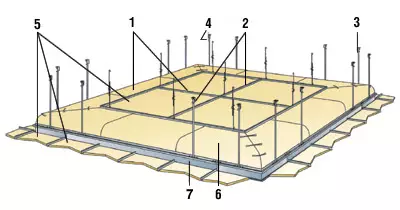
1. Head guide
2. Fixed guide
3. Jelly suspension
4. Regulated suspension
5. Slitting module
6.Inger panel
7.Shore profile of Kesson
Steer ceiling
Bearing is called structures in which carrier elements (metal bars, profiles) are attached directly to the base ceiling, and not hang on, as in the suspended systems. Therefore, the distance between the basic and stitched ceiling is determined only by the thickness of the carrier frames of the frame. Most often metallic rolls (similar to suspended rush) and tail drywall ceilings (design assembled from plasterboard sheets and metal or wooden frame). For wet premises, it is necessary to use moisture-resistant plasterboard (with the marking of HCCV). His sheets, in contrast to the usual gray Glk, are painted in green. In the Russian market, GLCV offers Gyproc (United Kingdom) and "Knauf-Gypsum" (Russia). Standard sheets of sheets - 25001200 and 30001200mm with a thickness of 12.5 mm (less often 9.5 and 6mm). Cost - from 70 rubles / m2. You can also grab the gypsumous material intended for wet premises (GVLV).Wet drywall is easily lightning and after drying takes a given shape. This property of the material is used in creating complex geometric sections of the surface (arches, domes, multi-level ceilings). Ceilings from G Clac today are quite popular - they are inexpensive, allow you to make the design of the most different configuration and equip them with built-in lighting. Wearing premises The ceiling plane is collected from several sheets, the seams are sinking with a sealing ribbon and processed with putty. After that, the surface must be primed and covered with any paint (both compositions should be intended for use in wet rooms).
"Star Sky"
In the bathroom, the ceiling "Starry Sky" will look very original. This is a stretch design of a PVC film of a dark color, equipped with a system of tiny lamps-stars. There are several technologies for creating the "sky":
1. Supporting optical fiber technology. Fiber can be placed relative to the ceiling plane in different ways. First, skip it through the cloth below the ceiling level by 10-50cm (the film is pre-punctured). In this case, the reflection of the luminous fiber in the stretch surface creates an additional decorative effect. Secondly, bring the tips of optical fiber threads to one level with the ceiling (the film is also punctured). The third embodiment is the fiber from the back side of the canvas close to its surface (the film does not puncture). In daytime lighting such a ceiling is a conventional smooth plane.
2. Sprinkling as luminous elements of crustals of the Austrian company Swarovski. With natural lighting, it is beautifully lit crustals, in the evening they give a rainbow game of light. Growth of lens provide inside the cartridges of beams of optical fiber threads. It is also possible to combine lens with optical fiber threads.
3. Suspens the LEDs that are displayed on the surface of the ceiling and look like tiny light bulbs. They are installed in special connectors and require a special power source. The programming panel allows you to set up to 10 flicker modes of diodes.
Stretch ceiling
The ceilings of stretch design are a thin film or tissue, stretched on a special frame (baguette). Baguette is mounted on the base ceiling or around the perimeter of the walls and, depending on the fastening method, can be visible or hidden. The resulting plane is ideally smooth and looks like a solid surface. Such ceilings made of PVC films or polyester fabric are manufactured, the framework in both cases is made of aluminum or PVC, but only more rigid than film. Code and increased air humidity Tensioning structures are completely immune, therefore, installed in wet rooms without any restrictions. With leakage from above, the cloth saves, forming a bubble. According to the manufacturers, the material withstands the load 100l / m2, the practical tests conducted by MAL-C, showed higher results to 170l / m2. You can drag the water through a similar emergency situation through a hole for the lamp (if the ceiling is equipped with a built-in light) or from one of the coating angles, which in this place will have to be temporarily dismantled (for what, of course, it will be necessary to call a specialist). The dried cloth is heated, and the ceiling completely restores its tension.
The disadvantage of the PVC film is that it does not have frost resistance, at temperatures below 0s, the material becomes rigid and fragile, however, it starts to collapse only at temperatures below -40С. Therefore, if you installed the stretch ceiling in a country house without permanent winter heating, be alert: try not to clap the door and do not touch the plane with sharp objects until the premises do not run.
The Russian market presents a fairly large number of firms offering stretch ceilings from PVC: Barrisol, Carre Noir, Grupa Dps, Extenzo, Novelum, Newmat, Prestige Design, Skol (France), Mondea (Netherlands), Deckenfest and Decomat (Germany). Polyester fabric ceilings produces only one company, Swiss Clipso.
The fundamental differences in the design of the ceilings from the PVC film from different manufacturers are not. When heated above 65С, the elasticity of the material increases, and it is well deformed, this property is used when installing the stretch ceiling.
The structures may differ from fasteners and the method of pulling the canvas (cartoon and flawless, cord and cam). With a harpoon method (Barrisol, Carre Noir, Decomat, Extenzo, Newmat), the coating is manufactured in strict accordance with the size of the room minus 10-15%. In return conditions, harpoon is welded to the edges of the prepared canvase. With a moneyborne method, careful measurements are not required, the product is simply delivered to the place, heat up to 70s and snap into the baguette.
Stretch ceilings can be installed in rooms of the most different configuration, building multi-level structures, arches and vaults.
Ceilings made of polyester clipso clips are mounted at room temperature. Color, in contrast to film coatings, are made after installation. The fabric is a frost-resistant material and is not afraid of negative temperatures, but it is impossible to create ceilings of a complex shape with it.
The minimum distance on which can be attached to the stretch ceiling from the base, is 0.5-3cm (depending on the fastener system).
When equipped with a stretch design in the built-in lighting, each lamp (usually point sources) is mounted using a separate suspension to the main ceiling, and the holes are cut in the canvas that are covered around the perimeter with a special thermal insulating ring. You can use lamps with a capacity of up to 60W (incandescent lamps) and up to 35W (halogen). To set the sources of greater power, additional thermal insulation is required between the case of the lamp and the plane of the ceiling, otherwise the film is simply melted.
The cost of the stretch ceiling is from $ 30 for 1m2, including installation, and the presence of complex constructive sites increases the amount up to $ 80s1m2.
The editors thanks the company "Dipris", "Decotek", "Karee Nouire", "Mal-C", "Planet Ceilkov", "Trekking Square", SKOL and Architect Igor Bobenko for help in the preparation of material.
